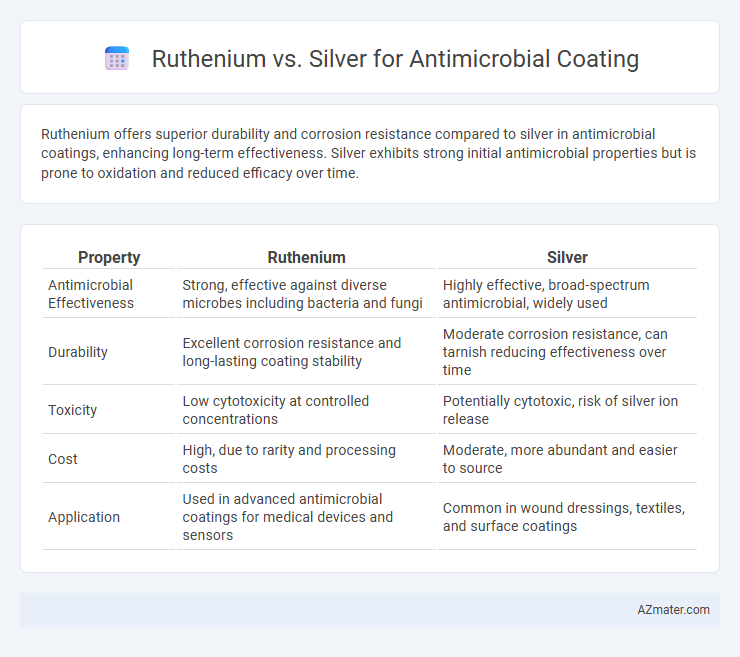Ruthenium offers superior durability and corrosion resistance compared to silver in antimicrobial coatings, enhancing long-term effectiveness. Silver exhibits strong initial antimicrobial properties but is prone to oxidation and reduced efficacy over time.
Table of Comparison
| Property | Ruthenium | Silver |
|---|---|---|
| Antimicrobial Effectiveness | Strong, effective against diverse microbes including bacteria and fungi | Highly effective, broad-spectrum antimicrobial, widely used |
| Durability | Excellent corrosion resistance and long-lasting coating stability | Moderate corrosion resistance, can tarnish reducing effectiveness over time |
| Toxicity | Low cytotoxicity at controlled concentrations | Potentially cytotoxic, risk of silver ion release |
| Cost | High, due to rarity and processing costs | Moderate, more abundant and easier to source |
| Application | Used in advanced antimicrobial coatings for medical devices and sensors | Common in wound dressings, textiles, and surface coatings |
Introduction to Antimicrobial Coatings
Antimicrobial coatings leverage materials like ruthenium and silver to inhibit microbial growth on surfaces, enhancing hygiene and reducing infection risks. Silver is widely used due to its proven broad-spectrum antimicrobial properties and ability to release ions that disrupt microbial cells. Ruthenium, an emerging alternative, offers improved durability and resistance to corrosion, potentially providing longer-lasting antimicrobial effects in harsh environments.
Chemical Properties of Ruthenium and Silver
Ruthenium exhibits high corrosion resistance and stable oxidation states, primarily +3 and +4, enhancing its durability and antimicrobial efficacy in coatings. Silver acts as a potent antimicrobial agent due to its ability to release Ag+ ions, which disrupt microbial cell membranes and metabolic pathways. While silver's chemical reactivity promotes rapid ion release, ruthenium's chemical stability ensures prolonged antimicrobial activity and resistance to environmental degradation.
Mechanisms of Antimicrobial Action
Ruthenium exhibits antimicrobial activity primarily through the generation of reactive oxygen species (ROS) that disrupt microbial cell membranes and interfere with DNA replication. Silver antimicrobial coatings release Ag+ ions, which bind to thiol groups in proteins, destabilizing cellular functions and causing structural damage to bacteria. Ruthenium's redox properties enable sustained ROS production, while silver's ion release offers broad-spectrum efficacy, making their mechanisms complementary in antimicrobial applications.
Efficacy Against Common Pathogens
Ruthenium exhibits superior antimicrobial efficacy against a broad spectrum of common pathogens, including Staphylococcus aureus and Escherichia coli, due to its unique catalytic properties that generate reactive oxygen species. Silver, traditionally used in antimicrobial coatings, effectively targets bacteria and fungi but may face resistance issues and lower long-term stability compared to ruthenium-based coatings. Ruthenium's enhanced durability and sustained antimicrobial action make it a promising alternative for high-touch surfaces and medical device applications.
Durability and Stability in Coatings
Ruthenium offers superior durability and chemical stability in antimicrobial coatings compared to silver, resisting oxidation and corrosion over extended periods. Silver coatings tend to degrade faster due to susceptibility to tarnishing and ion release under environmental exposure. The enhanced stability of ruthenium-based coatings ensures prolonged antimicrobial efficacy and reduces the need for frequent reapplication in harsh conditions.
Biocompatibility and Safety Concerns
Ruthenium demonstrates superior biocompatibility compared to silver, exhibiting lower cytotoxicity and reduced risk of adverse reactions in antimicrobial coatings. Silver, while effective against a broad spectrum of pathogens, poses concerns due to potential argyria and cellular toxicity at higher concentrations. Ruthenium's stable chemical properties and limited ion release contribute to safer, long-term applications in medical device coatings and implant surfaces.
Cost and Scalability of Production
Ruthenium offers superior antimicrobial properties but comes at a significantly higher cost compared to silver, impacting its economic feasibility for large-scale applications. Silver is more abundant and benefits from well-established, scalable production methods, making it a cost-effective choice for antimicrobial coatings across various industries. The scalability advantage of silver supports widespread deployment, whereas ruthenium's limited availability restricts its use to niche or high-performance settings where cost is less critical.
Environmental Impact and Toxicity
Ruthenium-based antimicrobial coatings exhibit lower environmental toxicity compared to silver, as ruthenium is less prone to bioaccumulation and releases fewer harmful ions into ecosystems. Silver nanoparticles, while effective antimicrobial agents, pose significant risks due to their persistence in aquatic environments, leading to toxicity in beneficial microorganisms and potential disruption of microbial communities. Lifecycle assessments indicate that ruthenium coatings have reduced ecological footprints, making them a more sustainable choice for antimicrobial applications.
Current Applications and Market Trends
Ruthenium-based antimicrobial coatings are gaining traction due to their stability, resistance to corrosion, and enhanced catalytic properties, making them suitable for medical devices and high-touch surfaces. Silver remains dominant in the market because of its proven broad-spectrum antimicrobial efficacy and cost-effectiveness, particularly in wound dressings and textiles. Recent trends show growing investment in ruthenium coatings for long-term antimicrobial applications, driven by increasing concerns over silver resistance and environmental impact.
Future Perspectives and Research Directions
Ruthenium exhibits promising antimicrobial properties with enhanced durability and resistance to bacterial colonization compared to silver, making it a potential material for next-generation antimicrobial coatings. Future research is focusing on optimizing ruthenium-based nanocomposites for controlled ion release and synergistic effects with other metals to improve biocompatibility and long-term efficacy. Advanced surface engineering techniques aim to integrate ruthenium coatings into medical devices and environmental applications, addressing challenges like cytotoxicity and cost-effectiveness.

Infographic: Ruthenium vs Silver for Antimicrobial Coating
 azmater.com
azmater.com